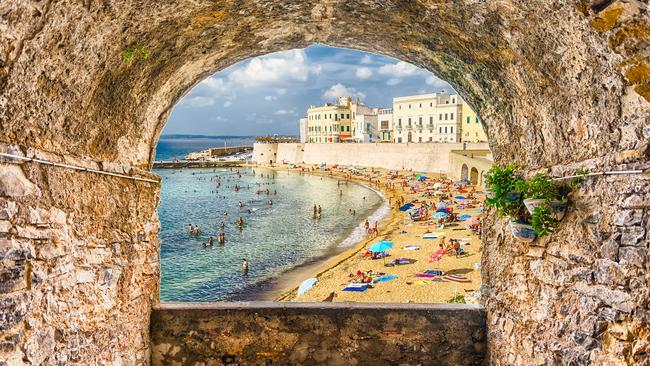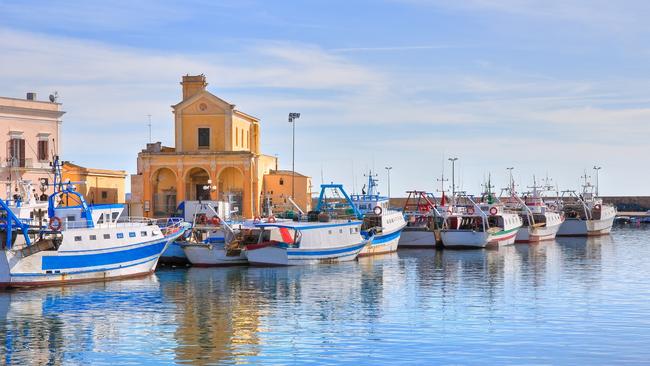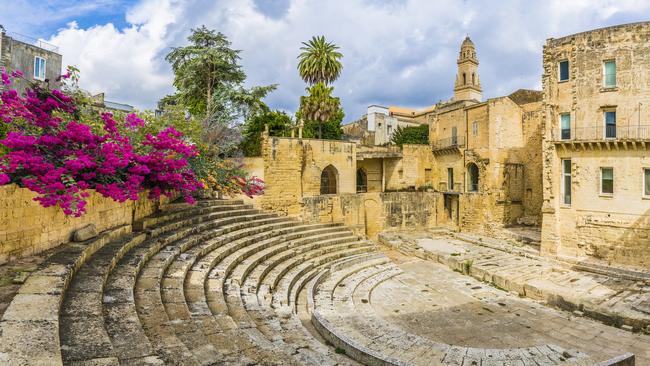It’s Gallipoli, but not as you know it
The Turkish peninsula is forever etched in the Australian psyche as a tragic and formative World War I battleground. This place, however, has an entirely different story.

A welcoming committee of harbour cats, dressed head to tail in black, greets our cruise ship as it nudges to the wharf in Gallipoli. For Australians, the name is forever associated with the Turkish peninsula where more than 11,000 Anzac soldiers died during World War I, but how many of us have heard of this historic town on the Salento Peninsula in Puglia, southern Italy, tucked down the heel of the boot?
The etymology of both names share the same Greek root, Kallipolis, meaning “beautiful city”, and it’s an accurate description of this almost unbearably pretty port on the Ionian Sea.
The ocean was rough last night, and the crews of fishing boats that made it out and back to harbour are licking their wounds. Fishermen sit in their boats mending nets, while the cats (I never do find out why they’re all black) meow on the margins, sniffing speculatively at the salty air and pouncing on the occasional fishy morsel tossed their way.

A defensive wall rises behind the harbour and surrounds the old town, built on a tiny island and crammed with Baroque churches, fountains, piazzas, whitewashed buildings and cobblestone laneways. The island is tethered to the mainland by a 16th-century stone bridge, and the threshold to the modern world is announced empathetically by a much-loathed but fittingly symbolic skyscraper nicknamed the “glass palace”. It’s possibly the only thing that’s not beautiful in the whole of Puglia.
I’ve arrived on Ponant ship L’Austral in late spring, which is a perfect time to visit, when it’s warm enough to swim and sip prosecco in the sun, but before the crowds arrive. At the height of summer, the Salento resorts heave with revellers (mostly domestic), who flock for the famous beach parties. But you can leave it as late as June and not feel overwhelmed. It’s still very much off the international radar.

This is the first year Ponant has come to Gallipoli, but the port is set to become a fixture for the French luxury line, which has a fleet of boutique ships (there are just 179 passengers on board) designed for boutique destinations. The theme of our 10-night Mediterranean cruise is “great civilisations”, and going by the size of the medieval castle that guards the town, this place has clearly seen a few come and go. From the time of its Greek beginnings it appears to have done little except defend against attacks. The Vandals, Venetians, Normans, Spanish and French all had a go.
Squint hard towards the north and you can just make out a watchtower on top of a grassy hill, one of more than 200 lookouts built around the 15th century. Smoke signals warning of invaders would be sent to military commanders in the grand castle, built a century or so earlier by the Byzantines (or the Angevin, depending on who you ask). The upper section of the castle tower was destroyed at the end of the 19th century, and today the castle is closed to visitors, or at least was when I tried to get in. Perhaps a smoke signal was sent to warn of my approach.

Unearthing the physical layers of history is hard in Gallipoli, as the town was destroyed and rebuilt so many times. Romans conquered, of course, but the only evidence of their presence (columns from an ancient temple) is submerged under the harbour.
For a terrestrial example of Roman ruins, head 40 minutes inland to Lecce, where you’ll find a stunning 2nd-century amphitheatre (only rediscovered in the early 20th century) alongside some of the most flamboyant examples of Baroque architecture found anywhere in Italy.
The ornate style flourished in Gallipoli, too, largely because between the 16th and 18th centuries the under-siege fishing village found itself filthy rich. The reason why is revealed below the Palazzo Granafei in the old town, where steps descend to a cool and cavernous olive mill dug into the limestone.

The olives pressed down here were destined not for salads but street lights. The finest lamp oil in the world was produced in dozens of subterranean pressing plants like this, and shipped all across Europe, with the water component sent to France to make the famous Marseilles soap. A guided tour of the mill (now a museum) will set you back €2 ($3.20), an outlay justified if just for the respite from the heat. With low-slung ceiling and a bewildering array of oversized clamps and racks, it has the feel of a medieval torture chamber, and for the workers who lived here 24 hours a day it probably was, not to mention the donkeys that walked in circles driving the giant millstone that crushed the olives. The stench must have been horrendous.
Back above ground, a sweeter aroma passes under my nose as I sample a sugar-glazed, almond and rice-flour biscuit called divino amore (divine love), a Salento special. Popular too is pasticciotto, a Pugliese pastry filled with creamy custard. Both treats are paired to perfection with a glass of Lecce coffee – espresso and almond syrup poured over ice. If you crave savoury, try a rustico leccese, a dangerously addictive pastry stuffed with bechamel sauce, mozzarella and tomato.

The sugar and caffeine hit propels me across the street to the beautiful 17th-century, Spanish-built Gallipoli Cathedral, with its Baroque facade and lavish Byzantine and Renaissance interiors. The martyrdom of Saint Agatha is depicted in an enormous canvas smeared across the ceiling. Admission is free, but a guided tour is a worthy (and meagre) investment. It’s also worth poking your head inside the Church of Saint Maria of Purity. Unassuming from the outside, the interior is a kaleidoscope of colour, with paintings covering every conceivable surface. One even rises mechanically (not unlike a caravan awning) to reveal a fresco underneath.
The church is conveniently located opposite the Beach of Purity – a gorgeous curl of golden sand and shallow turquoise water – and next door to a fine seafood restaurant, Santa Monaca, that whips up a black mussel soup with tomato and crusty bread. Any food you can’t finish, the cats will be happy to help.

In the know
Ponant’s Ancient Jewels of the Mediterranean cruise calls into Gallipoli in June 2025, part of a seven-night itinerary from Valletta to Athens; staterooms from $6660 a person, twin-share.
au.ponant.com
Ricky French was a guest of Ponant.
If you love to travel, sign up to our free weekly Travel + Luxury newsletter here.



To join the conversation, please log in. Don't have an account? Register
Join the conversation, you are commenting as Logout